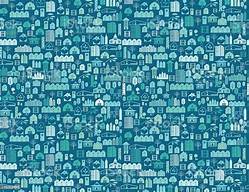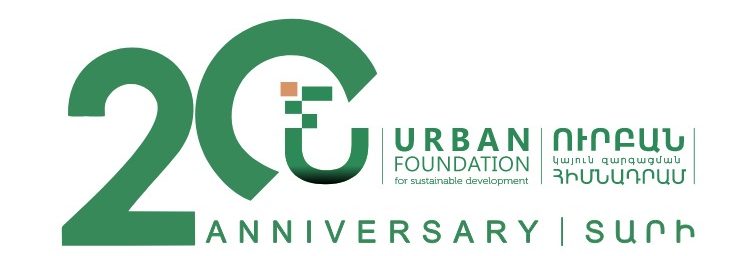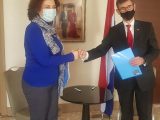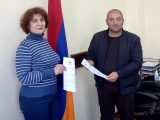
EMERGING FROM THE RUBBLE: REBUILDING HOMES AND LIVES IN GYUMRI
Monday, December 6, 2021

USAID Support in the Gyumri Recovery Zone (Late 1990s/Early 2000s)Image courtesy of Urban Foundation for Sustainable Development
Just over 20 years ago, USAID began a four year program that led to the revitalization of the city of Gyumri, jump-started a privatized housing market, and moved 7,000 households out of “temporary” housing after more than a decade following a devastating earthquake. The Earthquake Zone Recovery Program (EQRZP) followed a market-driven approach and demonstrated extraordinary cooperation among donors, civil society organizations, and the Government of Armenia. The program led to a highly successful model that the government continues to use today when assisting disaster victims. It also led to the formation of a local organization, the Urban Foundation for Sustainable Development(link is external), which continues to work on economic growth, climate issues, civic engagement, democratic reforms, community development, and regional cooperation. As USAID celebrates its 60th anniversary, and thirty years of partnership in Armenia, this story marks a critical role the United States played in helping Armenia recover from a horrible natural disaster.
In 1988, an earthquake devastated Gyumri, Armenia’s second largest city, and several surrounding communities, killing an estimated 50,000 people and injuring another 100,000. While international aid immediately poured in, the collapse of the Soviet Union disrupted rebuilding and recovery plans. The city remained in ruins for over a decade, with tens of thousands of people living amid the rubble in “domiks,” shipping containers converted into temporary housing. While Armenia underwent a rapid privatization of state-owned housing in the 1990s, the earthquake destroyed the buildings and residences in Gyumri that the government would have transferred to individual households, and privately financing a new home was out of reach for most families. Public buildings such as schools, government offices, and museums were also converted to shelters, and domiks occupied many public places such as parks and school yards.

Domiks in a public square in Gyumri- USAID Earthquake Recovery Zone Armenia / Դոմիկներ՝ Գյումրիի հանրային հրապարակում.Urban Foundation for Sustainable Development / Լուսանկարը տրամադրել է «Ուրբան» կայուն զարգացման հիմնադրամը

Sites of former buildings that had been razed by the earthquake and later cleared away. USAID Earthquake Recovery Zone Armenia / Նախկին շենքերի տարածքները, որոնք ավերվել էին երկրաշարժի հետևանքով և հետագայում մաքրվել:Urban Foundation for Sustainable Development / Լուսանկարը տրամադրել է «Ուրբան» կայուն զարգացման հիմնադրամը
More than a decade after the earthquake, the government faced a choice: to accept and formalize the domik slums and concentrate on new construction on the outskirts of the city, or reclaim the heart of Gyumri by clearing out the domiks and getting residents into new homes. In line with a World Bank-supported strategy, USAID conducted a small pilot program which offered approximately 100 families residing in domiks a monetary voucher that they could use toward the purchase of a new home in Gyumri or elsewhere in Armenia. Once the family had purchased a new home, the municipal government demolished their domik site. This pilot, implemented by the Urban Institute(link is external), simultaneously proved the cost effectiveness of offering vouchers, helped navigate a host of legal issues, and showcased the United States’ commitment to supporting Armenians.

Moving Domiks in Gyumri, Armenia- USAID Earthquake Recovery Zone Armenia / Լուսանկարը տրամադրել է «Ուրբան» կայուն զարգացման հիմնադրամըUrban Foundation for Sustainable Development
Over the next four years, USAID helped relocate 7,000 households, at the cost of only $3,450 per household. By rapidly expanding the number of people looking to buy a property all at once, this demand-shock increased home prices, which in turn spurred housing developers to enter the market and begin rebuilding Gyumri. The project focused its initial efforts on cleaning up areas along the main entrance to the city, and then expanded outward to clean and refurbish other historical routes around Gyumri. The project also provided house-improvement grants to families to help finish construction on new buildings or reinforce old structures, in an effort to ensure building quality standards. These improvements resulted in apartment values increasing by 62 percent.
A high level of cooperation among USAID, the Government of Armenia, other donors, and a range of non-governmental organizations (NGOs) was key to the project’s success. Organizations involved in the activity included the Lincy Foundation (now the Dream Fund), the All Armenian Fund, Norwegian Refugee Council, Huntsman Corp., UNDP/WFO, the Jinishian Memorial Fund, and Caritas. Local NGOs acted as real estate agents, helping guide participants through the home purchasing process, which for most, was their first home-buying experience. According to Armen Varosyan, who worked on the project as a young professional, and is now the Director of Business Development for the Urban Foundation for Sustainable Development, “exceptional donor coordination was a key determinant of the program’s success. There was also close cooperation between the program implementer and partners: community-based NGOs provided home-search assistance to vulnerable beneficiaries and monitored temporary shelter removal following the home purchase; commercial banks provided assistance to beneficiaries in home transactions and in making sure that housing to be purchased meets minimum required standards; and real estate agencies provided addresses for sale.”

Example of one of the voucher certificates beneficiaries could use toward the purchase of a new home. USAID Earthquake Recovery Zone Armenia / Բնակարանի գնման վկայագրերից մեկի օրինակը, որը շահառուները կարող էին օգտագործել նոր բնակարան գնելու համարUrban Foundation for Sustainable Development / Լուսանկարը տրամադրել է «Ուրբան» կայուն զարգացման հիմնադրամը
Today, the long term impacts of the project are clear with a revitalized and bustling Gyumri. The Government of Armenia continues to use the successful and proven voucher model when needed. From the rubble and ruin that remained for over a decade, USAID’s innovation, flexibility and market-driven approach helped revitalize one of Armenia’s most important cities, and established a framework for the government’s housing policies still used today.






